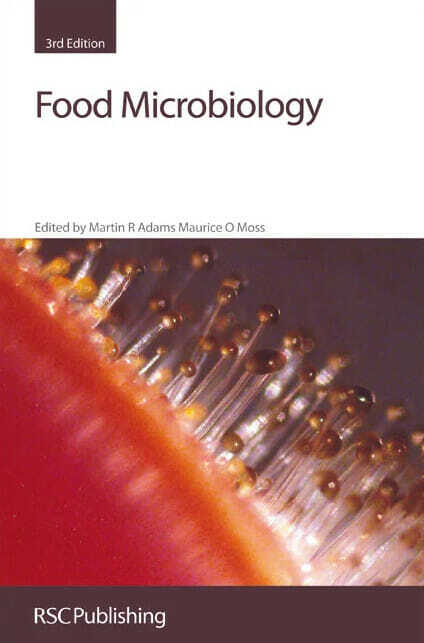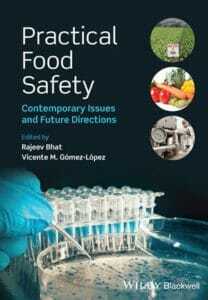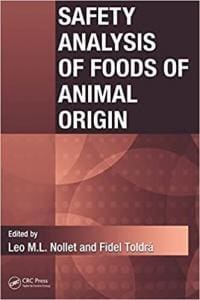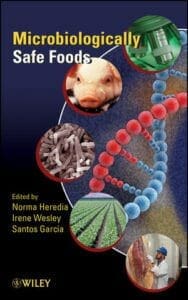Food Microbiology 3rd Edition

By by Martin R Adams Maurice O Moss
Read more: Analytical Methods for Food Safety by Mass Spectrometry, Volume I, Pesticides
Chapter 1 The Scope of Food Microbiology
1.1 Micro-organisms and Food 2
1.1.1 Food Spoilage/Preservation 2
1.1.2 Food Safety 4
1.1.3 Fermentation 4
1.2 Microbiological Quality Assurance 4
Chapter 2 Micro-organisms and Food Materials
2.1 Diversity of Habitat 5
2.2 Micro-organisms in the Atmosphere 6
2.2.1 Airborne Bacteria 7
2.2.2 Airborne Fungi 8
2.3 Micro-organisms of Soil 11
2.4 Micro-organisms of Water 13
2.5 Micro-organisms of Plants 15
2.6 Micro-organisms of Animal Origin 18
2.6.1 The Skin 18
2.6.2 The Nose and Throat 19
2.7 Conclusions 19
Chapter 3 Factors Affecting the Growth and Survival of
Micro-organisms in Foods
3.1 Microbial Growth 20
3.2 Intrinsic Factors (Substrate Limitations) 23
3.2.1 Nutrient Content 23
3.2.2 pH and Buffering Capacity 24
3.2.3 Redox Potential, Eh 28
3.2.4 Antimicrobial Barriers and
Constituents 32
3.2.5 Water Activity 36
3.3 Extrinsic Factors (Environmental Limitations) 45
3.3.1 Relative Humidity 45
3.3.2 Temperature 46
3.3.3 Gaseous Atmosphere 48
3.4 Implicit Factors 49
3.5 Predictive Food Microbiology 52
Chapter 4 The Microbiology of Food Preservation
4.1 Heat Processing 63
4.1.1 Pasteurization and Appertization 63
4.1.2 Quantifying the Thermal Death of Microorganisms:
D and z Values 66
4.1.3 Heat Sensitivity of Micro-organisms 68
4.1.4 Describing a Heat Process 72
4.1.5 Spoilage of Canned Foods 77
4.1.6 Aseptic Packaging 80
4.2 Irradiation 81
4.2.1 Microwave Radiation 82
4.2.2 UV Radiation 83
4.2.3 Ionizing Radiation 85
4.3 High-Pressure Processing–Pascalization 90
4.4 Low-Temperature Storage–Chilling and Freezing 92
4.4.1 Chill Storage 93
4.4.2 Freezing 96
4.5 Chemical Preservatives 98
4.5.1 Organic Acids and Esters 99
4.5.2 Nitrite 102
4.5.3 Sulfur Dioxide 106
4.5.4 Natamycin 107
4.5.5 ‘Natural’ Food Preservatives 107
4.6 Modification of Atmosphere 108
4.7 Control of Water Activity 112
4.8 Compartmentalization 115
Chapter 5 Microbiology of Primary Food Commodities
5.1 What is Spoilage? 119
5.2 Milk 121
5.2.1 Composition 121
5.2.2 Microflora of Raw Milk 123
5.2.3 Heat Treatment of Milk 127
5.2.4 Milk Products 130
5.3 Meat 131
5.3.1 Structure and Composition 132
5.3.2 The Microbiology of Primary Processing 134
5.3.3 Spoilage of Fresh Meat 136
5.4 Fish 139
5.4.1 Structure and Composition 140
5.4.2 The Microbiology of Primary Processing 140
5.4.3 Crustaceans and Molluscs 141
5.4.4 Spoilage of Fresh Fish 142
5.5 Plant Products 145
5.5.1 Cereals 147
5.5.2 Preservation of High-moisture Cereals 149
5.5.3 Pulses, Nuts and Oilseeds 149
5.5.4 Fruits and Fruit Products 151
5.5.5 Vegetables and Vegetable Products 153
Chapter 6 Food Microbiology and Public Health
6.1 Food Hazards 158
6.2 Significance of Foodborne Disease 160
6.3 Incidence of Foodborne Illness 165
6.4 Risk Factors Associated with Foodborne Illness 169
6.5 The Changing Scene and Emerging Pathogens 171
6.6 The Site of Foodborne Illness. The Alimentary
Tract: Its Function and Microflora 172
6.7 The Pathogenesis of Diarrhoeal Disease 176
Chapter 7 Bacterial Agents of Foodborne Illness
7.1 Aeromonas hydrophila 182
7.1.1 Introduction 182
7.1.2 The Organism and its Characteristics 183
7.1.3 Pathogenesis and Clinical Features 184
7.1.4 Isolation and Identification 184
7.1.5 Association with Foods 184
7.2 Bacillus cereus and other Bacillus Species 185
7.2.1 Introduction 185
7.2.2 The Organism and its Characteristics 186
7.2.3 Pathogenesis and Clinical Features 186
7.2.4 Isolation and Identification 188
7.2.5 Association with Foods 189
7.10.4 Isolation and Identification 233
7.10.5 Association with Foods 233
7.11 Plesiomonas shigelloides 234
7.11.1 Introduction 234
7.11.2 The Organism and its Characteristics 234
7.11.3 Pathogenesis and Clinical Features 235
7.11.4 Isolation and Identification 235
7.11.5 Association with Foods 235
7.12 Salmonella 235
7.12.1 Introduction 235
7.12.2 The Organism and its Characteristics 237
7.12.3 Pathogenesis and Clinical Features 238
7.12.4 Isolation and Identification 241
7.12.5 Association with Foods 244
7.13 Shigella 249
7.13.1 Introduction 249
7.13.2 The Organism and its Characteristics 250
7.13.3 Pathogenesis and Clinical Features 250
7.13.4 Isolation and Identification 251
7.13.5 Association with Foods 251
7.14 Staphylococcus aureus 252
7.14.1 Introduction 252
7.14.2 The Organism and its Characteristics 252
7.14.3 Pathogenesis and Clinical Features 254
7.14.4 Isolation and Identification 255
7.14.5 Association with Foods 256
7.15 Vibrio 257
7.15.1 Introduction 257
7.15.2 The Organisms and their Characteristics 259
7.15.3 Pathogenesis and Clinical Features 260
7.15.4 Isolation and Identification 261
7.15.5 Association with Foods 262
7.16 Yersinia enterocolitica 262
7.16.1 Introduction 262
7.16.2 The Organism and its Characteristics 263
7.16.3 Pathogenesis and Clinical Features 265
7.16.4 Isolation and Identification 266
7.16.5 Association with Foods 266
7.17 Scombrotoxic Fish Poisoning 267
7.18 Conclusion 268
Chapter 8 Non-bacterial Agents of Foodborne Illness
8.1 Helminths and Nematodes 270
8.1.1 Platyhelminths: Liver Flukes and Tapeworms 270
8.1.2 Roundworms 272
8.2 Protozoa 274
8.2.1 Giardia lamblia 275
8.2.2 Entamoeba histolytica 276
8.2.3 Sporozoid Protozoa 276
8.3 Toxigenic Algae 277
8.3.1 Dinoflagellate Toxins 277
8.3.2 Cyanobacterial Toxins 279
8.3.3 Toxic Diatoms 279
8.4 Toxigenic Fungi 280
8.4.1 Mycotoxins and Mycophagy 281
8.4.2 Mycotoxins of Aspergillus 282
8.4.3 Mycotoxins of Penicillium 290
8.4.4 Mycotoxins of Fusarium 292
8.4.5 Mycotoxins of Other Fungi 297
8.5 Foodborne Viruses 300
8.5.1 Polio 301
8.5.2 Hepatitis A and E 301
8.5.3 Gastroenteritis Viruses 303
8.5.4 Sources of Food Contamination 304
8.5.5 Control 306
8.6 Spongiform Encephalopathies 307
Chapter 9 Fermented and Microbial Foods
9.1 Introduction 310
9.2 Yeasts 312
9.3 Lactic acid Bacteria 314
9.4 Activities of Lactic Acid Bacteria in Foods 317
9.4.1 Antimicrobial Activity of Lactic Acid Bacteria 317
9.4.2 Health-promoting Effects of Lactic Acid
Bacteria-Probiotics 320
9.4.3 The Malo-lactic Fermentation 322
9.5 Fermented Milks 323
9.5.1 Yoghurt 323
9.5.2 Other Fermented Milks 327
9.6 Cheese 330
9.7 Fermented Vegetables 336
9.7.1 Sauerkraut and Kimchi 336
9.7.2 Olives 340
9.7.3 Cucumbers 341
9.8 Fermented Meats 343
9.9 Fermented Fish 346
9.10 Beer 348
9.11 Vinegar 356
9.12 Mould Fermentations 362
9.12.1 Tempeh 362
9.12.2 Soy Sauce and Rice Wine 365
9.12.3 Mycoprotein 368
9.13 Conclusion 369
Chapter 10 Methods for the Microbiological Examination of Foods
10.1 Indicator Organisms 370
10.2 Direct Examination 373
10.3 Cultural Techniques 374
10.4 Enumeration Methods 377
10.4.1 Plate Counts 377
10.4.2 Most Probable Number Counts 380
10.5 Alternative Methods 381
10.5.1 Dye-reduction Tests 382
10.5.2 Electrical Methods 382
10.5.3 ATP Determination 386
10.6 Rapid Methods for The Detection of Specific
Organisms and Toxins 388
10.6.1 Immunological Methods 388
10.6.2 DNA/RNA Methodology 389
10.6.3 Subtyping 393
10.7 Laboratory Accreditation 394
Chapter 11 Controlling the Microbiological Quality of Foods
11.1 Quality and Criteria 396
11.2 Sampling Schemes 399
11.2.1 Two-class Attributes Plans 399
11.2.2 Three-class Attributes Plans 402
11.2.3 Choosing a Plan Stringency 405
11.2.4 Variables Acceptance Sampling 407
11.3 Quality Control using Microbiological Criteria 410
11.4 Control at Source 412
11.4.1 Training 412
11.4.2 Facilities and Operations 413
11.4.3 Equipment 415
11.4.4 Cleaning and Disinfection 418
11.5 Codes of Good Manufacturing Practice 425
11.6 The Hazard Analysis and Critical Control Point
(HACCP) Concept 425
11.6.1 Hazard Analysis 428
11.6.2 Identification of Critical Control Points
(CCPs) 429
11.6.3 Establishment of CCP Critical Limits 429
11.6.4 Monitoring Procedures for CCPs 431
11.6.5 Protocols for CCP Deviations 431
11.6.6 Verification 432
11.6.7 Record Keeping 432
11.7 Quality Systems: BS 5750 and ISO 9000 Series 434
11.8 Risk Analysis 436
Chapter 12 Further Reading 440
Subject Index 447
You May Also Like:













![Ettinger’s Textbook of Veterinary Internal Medicine 9th Edition [PDF+Videos] Ettinger’s Textbook of Veterinary Internal Medicine 9th Edition [True PDF+Videos]](https://www.vet-ebooks.com/wp-content/uploads/2024/10/ettingers-textbook-of-veterinary-internal-medicine-9th-edition-100x70.jpg)

![Textbook of Veterinary Diagnostic Radiology 8th Edition [PDF+Videos+Quizzes] Thrall’s Textbook of Veterinary Diagnostic Radiology, 8th edition PDF](https://www.vet-ebooks.com/wp-content/uploads/2019/09/textbook-of-veterinary-diagnostic-radiology-8th-edition-100x70.jpg)






